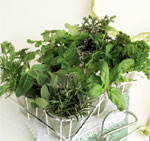Supermarkets and fruit and vegetable shops stock a wide range of herbs, and some herbs are also easy to grow yourself.
Fragile herbs
Parsley
There are two varieties of parsley – curly and flat leaf. Flat-leaf parsley has a fuller, slightly stronger flavour and goes really well with Italian and French dishes. Parsley has a mild flavour, so you can use a large quantity without fear of it overpowering the dish. It is better to add parsley towards the end of the cooking time to preserve the flavour, or add it raw to salads or dressings. The mild flavour makes it versatile and it goes with many different flavours. Don’t use it in very spicy or strongly flavoured dishes though, as the flavour
will be lost.
Coriander
Also known as cilantro or dania, this herb has a fresh and fragrant flavour that is quite distinctive. It is a herb that people either love or hate. It is used extensively in Asian and Latin American cuisine and is particularly good with spicy food. It can be used in substantial quantities, especially if the dish is going to be cooked further after adding the coriander. To preserve the flavour, add it towards the end of the cooking time, or sprinkle on top after cooking.
Basil
A fragrant herb that perfectly partners Mediterranean-style food. It’s also a popular ingredient in the East that is often added to curries and salads. The flavour will be lost with long cooking, so add it towards the end of the cooking time. When adding basil to salads or using it raw, shred the leaves close to the serving time because they bruise easily and tend to go black after a while. Basil can be used liberally and is extremely versatile, but is best with Mediterranean and tomato-based dishes or salads.
Mint
There are quite a few varieties. If you intend growing your own, ask the nursery which ones are best for cooking. Spearmint is a good choice and is available in supermarkets. Mint is used in many Middle Eastern dishes, and to make soothing teas, refreshing drinks and jellies. It can be used quite liberally and should be added near the end of the cooking time. Use in salsas or sambals that are served with spicy food as mint has a cooling effect on the palate. It is delicious added to Middle Eastern dishes, spicy food, lamb dishes, salads, fruit punches and teas.
Robust Herbs
Rosemary
A strong-flavoured, hardy herb that is excellent with lamb dishes, rosemary is best added at the start of the cooking process, allowing time for the herb to soften and the flavour to be released. It has a strong flavour that can be overpowering, so use it sparingly. Add rosemary to Greek dishes (especially lamb), meat or venison stews, or to flavour vinegars and oils.
Origanum
This herb complements Mediterranean-style and tomato-based dishes. It’s not as strong as rosemary, so you can use it quite liberally and add it at the start of the cooking time. Origanum is delicious on pizzas, in pasta sauces and in meat, poultry or fish marinades or meat stews.
Sage
Traditionally used in stuffing and sausages, sage has a distinctive flavour that goes well with pork. Add at the start of the cooking time and use in moderation. Sage also goes well with veal, pork and chicken, and is delicious in pasta sauces.
Dill
Dill has fine, feathery leaves and an aniseed flavour. Commonly used in Greek and Scandinavian cooking and often with fi sh, it should be added in moderation. The flavour can withstand long cooking. Dill can be added to soups and stews, salads and salad dressings, or be used as a garnish. It is especially good with smoked salmon.
Thyme
Thyme benefi ts from being added to dishes that are cooked slowly as this will help release the flavour. Use it in small quantities however, because the flavour is quite strong and can easily overpower the dish. Thyme is a classic ingredient that is often used in the making of stocks, sauces and slow-cooked stews and soups. The flavour also combines well with vegetable, meat, poultry and seafood dishes.
Good Idea
Use the flowers from herb plants in salads. They are also edible, and a great way to add interest and colour to a bowl of crunchy greens.
Image: Ideas/Anèl Van Der Merwe

